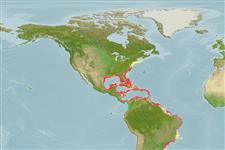Classification / Names
Common names from other countries
Main reference
Size / Weight / Age
Max length : 94.0 cm TL male/unsexed; (Ref. 40637); common length : 50.0 cm TL male/unsexed; (Ref. 55); max. published weight: 15.6 kg (Ref. 26340); max. reported age: 29 years (Ref. 46200)
Length at first maturity
Lm 52.0, range 28 - 40 cm
Environment
Marine; brackish; reef-associated; depth range 25 - 95 m (Ref. 9626), usually 40 - 70 m (Ref. 9626)
Climate / Range
Tropical; 20°C - 28°C, preferred ?; 43°N - 28°S, 98°W - 31°W (Ref. 55226)
Distribution
Western Atlantic: Massachusetts, USA and Bermuda (Anderson, pers. comm.) to southeastern Brazil, including the Caribbean Sea and the Gulf of Mexico (Ref. 9626). Most abundant around the Antilles, the Bahamas and off southern Florida.
Countries | FAO areas | Ecosystems | Occurrences | Introductions
Short description
Dorsal
spines
(total): 10 - 11;
Dorsal
soft rays
(total): 13-14;
Anal
spines: 3;
Anal
soft rays: 7 - 8. Preopercular notch and knob weak. Pectoral fins are long, reaching level of anus. Scale rows on back rising obliquely above lateral line. Back and upper sides olive green, whitish with a red tinge on lower sides and belly. A black spot is on the upper back just above the lateral line and below the anterior dorsal fin rays. A pair of blue stripes runs on the snout-cheek region, the upper continuing behind eye to upper opercle edge.
IUCN Red List Status (Ref. 115185)
Threat to humans
Reports of ciguatera poisoning (Ref. 30303)
Human uses
Fisheries: highly commercial; gamefish: yes; aquarium: commercial
More information
ReferencesAquacultureAquaculture profileStrainsGeneticsAllele frequenciesHeritabilityDiseasesProcessingMass conversion
Tools
Special reports
Download XML
Internet sources
Estimates of some properties based on models
Phylogenetic diversity index
PD50 = 0.5000 many relatives (e.g. carps) 0.5 - 2.0 few relatives (e.g. lungfishes)
Trophic Level
3.9 ±0.2 se; Based on diet studies.
Resilience
Low, minimum population doubling time 4.5 - 14 years (K=0.13-0.25; tm=5.5; tmax=14)
Vulnerability
High vulnerability (55 of 100)
Price category
